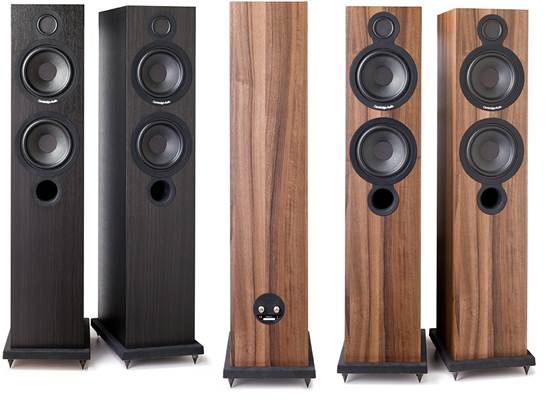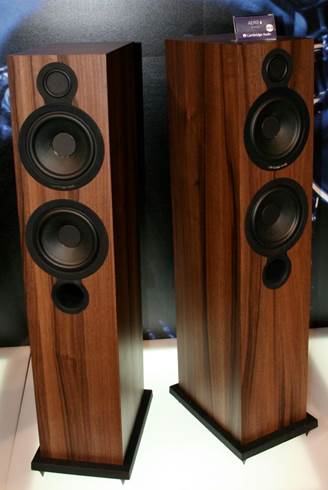However, those used to the spectacle of kicking, crashing
and banging budget boxes will be disappointed – they’ll accuse the Aero of
being too polite, of not having enough bite. And they’ll say it is ‘boring’
because it doesn’t ‘kick asses. Listen carefully, however, and it does – as the
6 in driver in the Aero shifts a good deal more air than most 4in-equipped
rivals like the Q Acoustics Concept 20. It shows itself better able to
withstand the rigors of powerful modern music such as Kanye West’s Say You
Will. Even in a medium to largish listening room, you can really feel the
electronic percussion hit home. There’s a fine sense of solidity, plus the
ability to go louder with less compression apparent. The thing is, though, that
there’s no big, lumpy peak around 100Hz that gives so many small stand mounts
an apparently big, bossy showroom sound (along with the one-note bass to
match). Instead, the Aero 2’s low end is smooth and devoid of trickery.

The Aero 2’s low
end is smooth and devoid of trickery.
The quality of the treble is excellent; Genesis’s Robbery,
Assault and Battery has some lovely hi-hat and ride cymbal work and the Aero 2
shows how smooth and delicate it can be; there’s no sense of grain or
coarseness from the BMR, and it spreads out around the room beautifully.
However, sometimes a little extra bite would be nice; it’s almost as if the
unit is over smooth and it almost doesn’t seem right on a budget speaker whose
first job is to entertain. It’s an odd remark to make perhaps, but certainly
with subtle high-quality front ends this speaker can almost sound that little
bit too refined with thumping rock music.

The Aero’s drivers
are, of course, bespoke; the BMR is the very latest fourth-generation unit –
which designer Dominic Baker says is newer than the BMRs in any other
commercially available loudspeaker currently on sale, some of which are still
running first-gen designs.
It’s a different matter with classical, of course, where the
Aero soars. It delivers a large-scale sound on the Berlin Philharmonic’s
rendition of Beethoven’s Pastoral Symphony, with an accurately rendered
orchestra floating in space. Violins are amazing to behold, as they’re right
where normal two-way speakers crossover, yet with these little boxes you get a
wonderfully balanced and phase-coherent sense; they hang in the recorded
acoustic with total assuredness, and sound raw and realistic yet never grate.
Lower down, cellos grumble menacingly, yet these speakers seem to have plenty
in reserve when the music reaches a crescendo; I’ve heard many pricier designs
sit on transients and compress things much more. Overall, you get a refined and
natural sound completely unexpected at this price.
On test
A sensitivity of 90dB is claimed for the Aero 2, but our
measured figure of 85.9dB on pink noise indicates that this is substantially
optimistic. Nominal impedance is quoted as “8ohms compatible”, but the modulus
drops to a minimum of 3.4ohms at 138Hz, making a 4ohm nominal figure more
appropriate. Impedance phase angle is also quite large at low frequencies, so
the EPDR (equivalent peak dissipation resistance) falls to 1.6ohms at 98Hz and
1.9ohms at 171Hz, making the Aero 2 quite a challenging amplifier load overall,
although at higher frequencies the Balanced Mode Radiator (BMR) driver is
benignly resistive. Frequency response, measured on the BMR axis, was flat to
within ±2.5dB and ±2.8dB respectively for the review pair, 200Hz-20 kHz – an
excellent result for a passive speaker.
Pair matching over the same frequency range was less good at
±1.6dB, but below 15 kHz the disparity reduced to less than ±1.0dB.
Diffraction-corrected near-field measurement recorded a bass extension of 57Hz
for -6dB ref 200Hz – fair for a speaker of this size – but showed the upper
bass to have a peak of about 4dB at 100Hz. The cumulative spectral decay
waterfall was clean, with fast initial energy decay across the spectrum and
well-suppressed resonances.
How it compares
The direct rival to the Aero 2 is Q Acoustics Concept 20,
which sports a very robust, well-damped cabinet that’s a good bit smaller than
the Aero, plus a 25mm polyester dome tweeter and a 125mm mid/bass driver,
crossing over at 2.9 kHz. The result is a lovely sounding speaker with a smooth,
musical sound – in many ways similar to the Aero – but it isn’t as seamless
across the midland, and doesn’t have the clarity at higher levels. This is
likely down to the Aero’s larger 165mm bass driver, and the fact it needs to do
less work as it crosses over so much lower. The Aero compresses the music less
at high volumes, and drives larger rooms with ease.
BMR tech
Conventional moving coil drive units act historically at low
frequencies, with the diaphragm moving as a rigid whole. As frequency increases,
two undesirable things happen: the acoustical output becomes confined to a
progressively narrower forward angle – an effect known as ‘beaming’ – and
flexure in the diaphragm results in resonances rather dramatically termed
‘breakup’, although no physical damage occurs. The Balanced Mode Radiator (BMR)
is a cleverly elaborated form of moving-coil driver, which overcomes these
problems using a flat diaphragm with carefully placed annular masses. The end
result is a drive unit with an unusually wide pass band – from 250Hz to well
over 20kHz in the Aero 2 – with considerably less beaming and better controlled
resonances.
Conclusion
Just in case you hadn’t noticed then, I love the new
Cambridge Audio Aero 2s; they’re an exotic little loudspeaker that’s simply not
built in quite the same way as its rivals – and for good reason. The result is
an extremely open and seamless sound at the price, one that shares more with a
high-end electrostatic than a cheapo box speaker, in some respects. Still, such
sophistication will not be for everyone – some might find them a little lacking
in ‘bite’; such people are well served with many other designs! Go and hear the
Aero 2 if you can then, and don’t be put off by the staid looks, because the
nature of its engineering is precisely the reverse.

Cambridge Audio
Aero 2s is an exotic little loudspeaker that’s simply not built in quite the
same way as its rivals – and for good reason.
Our verdict
·
Sound quality: 5/5
·
Value for money: 5/5
·
Build quality: 4.5/5
·
Ease of drive: 5/5
·
Like: Superbly smooth, open, seamless sound; musicality
·
Dislike: Looks are a little on the bland side, but that’s it at
the price
·
We say: Brilliant small stand mount engineered for stunning sonic
·
Overall: 5/5
|
Technical
specs
·
Type: Stand mount loudspeaker
·
Weight: 6.8kg
·
Dimensions (W x H x D): 203 x 70 x 311mm
·
Features : 1x 46mm BMR treble/mid driver; 1x 165mm paper
bass driver; Quoted power handling: 25-120W; Quoted sensitivity: 90dB/1W/1m;
Quoted frequency response: 40Hz-22kHz (+/- 3dB)
|